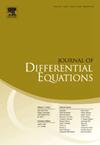Existence and convergence of stochastic processes underlying a thin layer approximation of a coupled bulk-surface PDE
IF 2.4
2区 数学
Q1 MATHEMATICS
引用次数: 0
Abstract
We study a system of coupled bulk-surface partial differential equations (BS-PDEs), describing changes in concentration of certain proteins (Rho GTPases) in a living cell. These proteins, when activated, are bound to the plasma membrane where they diffuse and react with the inactive species; inactivated species diffuse inside the cell cortex; these react with the activated species when they are close to the plasma membrane. For our case study, we model the cell cortex as an annulus, and the plasma membrane as its outer circle.
Mathematically, the aim of the paper is twofold: Firstly, we show the master equation for the changes in concentration of Rho GTPases is the Kolmogorov forward differential equation for an underlying Feller stochastic process, and, in particular, the related Cauchy problem is well-posed. Secondly, since the cell cortex is typically a rather thin domain, we study the situation where the thickness of the annulus modeling the cortex converges to 0. To this end, we note that letting the thickness of the annulus to 0 is equivalent to keeping it constant while increasing the rate of radial diffusion. As a result, in the limit, solutions to the master equation lose dependence on the radial coordinate and can be thought of as functions on the circle. Furthermore, the limit master equation can be seen as describing diffusion on two copies of the circle with jumps from one copy to the other.
体表耦合 PDE 薄层近似下随机过程的存在性和收敛性
本文章由计算机程序翻译,如有差异,请以英文原文为准。
求助全文
约1分钟内获得全文
求助全文
来源期刊
CiteScore
4.40
自引率
8.30%
发文量
543
审稿时长
9 months
期刊介绍:
The Journal of Differential Equations is concerned with the theory and the application of differential equations. The articles published are addressed not only to mathematicians but also to those engineers, physicists, and other scientists for whom differential equations are valuable research tools.
Research Areas Include:
• Mathematical control theory
• Ordinary differential equations
• Partial differential equations
• Stochastic differential equations
• Topological dynamics
• Related topics

 求助内容:
求助内容: 应助结果提醒方式:
应助结果提醒方式:


